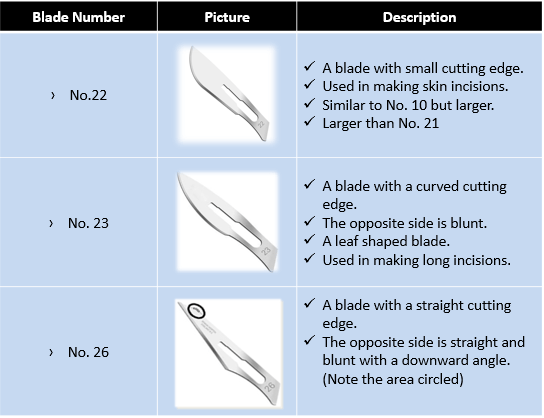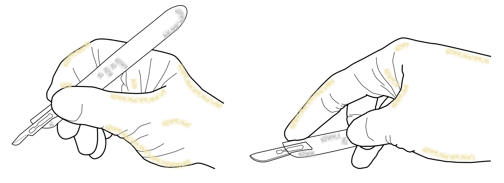One of the oldest surgical instruments used even today is a Scalpel (Surgical Blade with a Bard Parker Handle). Long before using metals in manufacturing, parts from various flora and fauna were used in making incisions during surgeries. Few examples are listed below.

Table 1. Various objects used to make incisions.
The first recorded circumcision was carried out using stones such as jade and flint. Their edges were modified sharp using various techniques. Gradually in 3000 BC metal such as copper, bronze and iron were used as blades after sharpening their edges. In 400 BC, Hippocrates described the first scalpel in surgical use as a “Macairion”. The similar instrument was named as “Scallepellus” by the Romans which was modified into the present-day word that we use as a “Scalpel”.
The concept of Asepsis and sterilization led to more changes in the material and structure of the scalpel. In 1900’s Morgan Parker introduced the principle of disposable blades could be used with a reusable handle. It was from then, Bard-Parker (CR Bard was a medical instrument supplier) handle was manufactured in a large scale and used widely in all surgeries. In the recent times alloys are used to manufacture the blades such as stainless steel as it has a higher resistance to corrosion. Modern evolution has polymer, chromium and diamond coating to improve the sharpness of the blade.
Types of Blades
Based on the surgeries, location of an incision and usage there are various types of blades with different sizes and shapes which are labeled with numbers. The list of blades commonly used are described below.
Each of them has a compatible BP Handles. BP Handles are also numbered based on their size.
- Handle No. 3 is compatible with Blade No. 10, 11, 12 and 15. It is the most common handle used in making incisions. A subtype No. 3G has a graduated scale present over the handle to measure structures. Another subtype No. 3L is a longer version of No. 3
- Handle No. 4 is compatible with Blade No. 20, 21, 22, 23 and 26. It is similar to No. 3 but has a larger tip for accommodation of large blades. No. 4G has graduations along the handle No. 4L is a longer version of No. 4.
- Handle No. 7 is compatible with Blade No. 10, 11, 12 and 15. It is a long and slender handle with is useful in making incisions in deep and tight spaces.



How is scalpel used?
The scalpel as said before is used in making the incisions, one of the first and the essential instruments used in the Operation Theater. It can be held in different ways based on the type of incision needed.
- Palmar Grip – Here it is held between the thumb and the middle, ring and 5th fingers with the index finger over the upper border of the handle. The handle lies clutched in the palm. This grip is used while making incisions on tough tissues. A Periosteal Elevator is also held in a similar manner. The movement in this position arises from the shoulder.
- Pencil Grip – Here it is held as a pencil which is used in making small, precision cuts where handle lies over the palm. In this position movement is given from the fingers to make fine cuts.
Finger-Tip Grip – A modification of Palmar grip where the scalpel is held with the fingertips and the handle lies under the palm. Here more length of blade lies in contact with the skin hence used in making long incisions, usually the on the skin.
Stab Grip – A modification of Pencil grip where the scalpel is held at a 90o angle to the skin surface. This position help in allowing maximum control over penetration into the surface. It is used while making ports for laparoscopic surgeries.

One always needs to keep in mind to pass the scalpel in a Kidney Tray or by keeping the sharp side towards him/herself.
- Blades being sharps need to be discarded carefully, an attempt must be made to segregate them as soon as their purpose is completed. They must be put in a white plastic container with a black lid which would be sent to incineration. The handles may be reused after adequate sterilization.
Summary
The most important act done during the surgery is to create an incision to proceed further, this has been done using the oldest surgical instrument known to the medical field, a Scalpel. Though the name of the instrument has changed and evolved to what it is called today, it has had the same use.
There were many naturally available sources which were crafted to serve the purpose, such as bamboo sticks, shark teeth, fingernails and obsidian. In the recent times the invention of alloys has taken over the use of the age-old sources. Stainless steel, titanium and various metals are being used, in order to make them durable and strong they are being coated with diamond or chromium too.
The blades are compatible with a Bard Parker Handle when combined make a Scalpel. The blades are of various sizes and are numbered. Each of them has a special use.
The BP handle is also available in various sizes and are numbered. They may be reused after sterilization.
Blades being sharps need to be discarded with utmost care and sent to incineration.

Graduated from one of the famous institutions in Telangana, Kamineni Institute of Medical Sciences. He has always been fond of writing articles in Medicine. Since the undergraduate years was interested in making creative Presentations and taking seminars.

How to give precise incision,?
Good description. Well written .well narrated the grips and applications